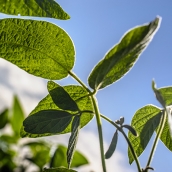DOI: 10.1111/gcb.12567
Simultaneous improvement in productivity, water use, and albedo through crop structural modification
Abstract

Spanning 15% of the global ice-free terrestrial surface, agricultural lands provide an immense and near-term opportunity to address climate change, food, and water security challenges. Through the computationally informed breeding of canopy structural traits away from those of modern cultivars, we show that solutions exist that increase productivity and water use efficiency, while increasing land-surface reflectivity to offset greenhouse gas warming. Plants have evolved to maximize capture of radiation in the upper leaves, thus shading competitors. While important for survival in the wild, this is suboptimal in monoculture crop fields for maximizing productivity and other biogeophysical services. Crop progenitors evolved over the last 25 million years in an atmosphere with less than half the [CO2] projected for 2050. By altering leaf photosynthetic rates, rising [CO2] and temperature may also alter the optimal canopy form. Here using soybean, the world's most important protein crop, as an example we show by applying optimization routines to a micrometeorological leaf canopy model linked to a steady-state model of photosynthesis, that significant gains in production, water use, and reflectivity are possible with no additional demand on resources. By modifying total canopy leaf area, its vertical profile and angular distribution, and shortwave radiation reflectivity, all traits available in most major crop germplasm collections, increases in productivity (7%) are possible with no change in water use or albedo. Alternatively, improvements in water use (13%) or albedo (34%) can likewise be made with no loss of productivity, under Corn Belt climate conditions.
